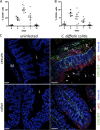Critical role for MyD88-mediated neutrophil recruitment during Clostridium difficile colitis
- PMID: 22689818
- PMCID: PMC3418725
- DOI: 10.1128/IAI.00448-12
Critical role for MyD88-mediated neutrophil recruitment during Clostridium difficile colitis
Abstract
Clostridium difficile can infect the large intestine and cause colitis when the normal intestinal microbiota is altered by antibiotic administration. Little is known about the innate immune signaling pathways that marshal inflammatory responses to C. difficile infection and whether protective and pathogenic inflammatory responses can be dissociated. Toll-like receptors predominantly signal via the MyD88 adaptor protein and are important mediators of innate immune signaling in the intestinal mucosa. Here, we demonstrate that MyD88-mediated signals trigger neutrophil and CCR2-dependent Ly6C(hi) monocyte recruitment to the colonic lamina propria (cLP) during infection, which prevent dissemination of bystander bacteria to deeper tissues. Mortality is markedly increased in MyD88-deficient mice following C. difficile infection, as are parameters of mucosal tissue damage and inflammation. Antibody-mediated depletion of neutrophils markedly increases mortality, while attenuated recruitment of Ly6C(hi) monocytes in CCR2-deficient mice does not alter the course of C. difficile infection. Expression of CXCL1, a neutrophil-recruiting chemokine, is impaired in the cLP of MyD88(-/-) mice. Our studies suggest that MyD88-mediated signals promote neutrophil recruitment by inducing expression of CXCL1, thereby providing critical early defense against C. difficile-mediated colitis.
Figures







Similar articles
-
Protective role of commensals against Clostridium difficile infection via an IL-1β-mediated positive-feedback loop.J Immunol. 2012 Sep 15;189(6):3085-91. doi: 10.4049/jimmunol.1200821. Epub 2012 Aug 10. J Immunol. 2012. PMID: 22888139 Free PMC article.
-
Role of interferon-γ and inflammatory monocytes in driving colonic inflammation during acute Clostridium difficile infection in mice.Immunology. 2017 Apr;150(4):468-477. doi: 10.1111/imm.12700. Epub 2017 Jan 30. Immunology. 2017. PMID: 27995603 Free PMC article.
-
Interleukin-23 (IL-23), independent of IL-17 and IL-22, drives neutrophil recruitment and innate inflammation during Clostridium difficile colitis in mice.Immunology. 2016 Jan;147(1):114-24. doi: 10.1111/imm.12545. Epub 2015 Dec 2. Immunology. 2016. PMID: 26455347 Free PMC article.
-
Teaching old mice new tricks: the utility of aged mouse models of C. difficile infection to study pathogenesis and rejuvenate immune response.Gut Microbes. 2021 Jan-Dec;13(1):1966255. doi: 10.1080/19490976.2021.1966255. Gut Microbes. 2021. PMID: 34432545 Free PMC article. Review.
-
Neutrophil-mediated inflammation in the pathogenesis of Clostridium difficile infections.Anaerobe. 2016 Oct;41:85-90. doi: 10.1016/j.anaerobe.2016.04.001. Epub 2016 Apr 5. Anaerobe. 2016. PMID: 27063896 Free PMC article. Review.
Cited by
-
Role of obesity and adipose tissue-derived cytokine leptin during Clostridium difficile infection.Anaerobe. 2015 Aug;34:182-6. doi: 10.1016/j.anaerobe.2014.12.009. Epub 2015 Jan 29. Anaerobe. 2015. PMID: 25638400 Free PMC article. Review.
-
The sympathetic nervous system drives hyperinflammatory responses to Clostridioides difficile infection.Cell Rep Med. 2024 Oct 15;5(10):101771. doi: 10.1016/j.xcrm.2024.101771. Epub 2024 Oct 4. Cell Rep Med. 2024. PMID: 39368481 Free PMC article.
-
Protection against Clostridioides difficile disease by a naturally avirulent C. difficile strain.bioRxiv [Preprint]. 2024 May 7:2024.05.06.592814. doi: 10.1101/2024.05.06.592814. bioRxiv. 2024. Update in: Cell Host Microbe. 2025 Jan 8;33(1):59-70.e4. doi: 10.1016/j.chom.2024.11.003. PMID: 38766138 Free PMC article. Updated. Preprint.
-
Butyrate Protects against Clostridium difficile Infection by Regulating Bile Acid Metabolism.Microbiol Spectr. 2023 Aug 17;11(4):e0447922. doi: 10.1128/spectrum.04479-22. Epub 2023 Jun 23. Microbiol Spectr. 2023. PMID: 37350595 Free PMC article.
-
Host Immune Responses to Clostridioides difficile Infection and Potential Novel Therapeutic Approaches.Trop Med Infect Dis. 2023 Nov 23;8(12):506. doi: 10.3390/tropicalmed8120506. Trop Med Infect Dis. 2023. PMID: 38133438 Free PMC article. Review.
References
-
- Adachi O, et al. 1998. Targeted disruption of the MyD88 gene results in loss of IL-1- and IL-18-mediated function. Immunity 9:143–150 - PubMed
-
- Chen X, et al. 2008. A mouse model of Clostridium difficile-associated disease. Gastroenterology 135:1984–1992 - PubMed
-
- Daley JM, Thomay AA, Connolly MD, Reichner JS, Albina JE. 2008. Use of Ly6G-specific monoclonal antibody to deplete neutrophils in mice. J. Leukoc. Biol. 83:64–70 - PubMed
Publication types
MeSH terms
Substances
Grants and funding
LinkOut - more resources
Full Text Sources
Other Literature Sources
Medical
Molecular Biology Databases
Miscellaneous

